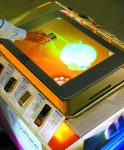
RFID becomes one of the core technologies of Microsoft’s interface system Surface
[ad_1]
Imagine this scenario—on a sunny afternoon, you walk into a corner cafe and sit down leisurely, and the words “Welcome, please order” are immediately displayed on the table in front of you, along with pictures and texts. menu and presentation. You only need to raise your hand and lightly touch the table, and the waiter will quickly bring you steaming coffee.
Maybe you still need some music as a foil, then please click on the “Dynamic Fashion” music section on the dining table, select the style of the track you like, and all the album covers will appear in front of you. Drag and drop your favorite tracks to the playlist on the desktop, then put on your headphones, and you can easily enjoy your own afternoon. After a break, are you going back to work? Then just take out the credit card and put it on the desktop, the consumption status, credit limit and other related information will be displayed next to it, tap to pay, get up and leave.
——You may think that such a scene will only appear in science fiction movies, but now, it has actually come to us. This is the computer integrated interaction that Microsoft will officially put on the market this year, today. Flat system – “Microsoft interface” (Microsoft Surface).

Surface’s latest conceptual demonstration (data map)
Keywords for Surface
Microsoft Surface (hereinafter referred to as Surface) is a computer integrated interactive plane system. As Microsoft’s first flat computer, Surface can generate a large amount of information interaction without a traditional mouse and keyboard, as long as it is through human gestures, touch – or even direct physical contact with other objects. The significance of innovation is self-evident.
Surface can also be called a desktop computer — that’s not the computer that sits on top of it, or the “desktop” in your Windows system. This is a real desktop, and it will also become a real computer.
Multi-touch is a technology that can receive multiple touch input signals at the same time, and it is also the core technology of Surface. Surface can support up to ten people sharing the desktop at the same time. The combination of physical recognition and touch recognition can trigger different types of digital responses according to the user’s needs, thus creating a powerful function of Surface.
Although the multi-touch input screen is widely known, among all the non-traditional control methods we have seen in the past, there is no interaction method that is more intuitive, detailed, and lively than Surface, and can better cross the boundary between virtual and reality.
RFID Radio frequency identification, also known as electronic tags. RFID is a non-contact automatic identification technology, and it is also one of the cores of Surface. It automatically identifies target objects and obtains relevant data through radio frequency signals, and at the same time completes the work of viewing and modifying data information. The identification process does not require manual intervention and can work in various harsh environments. In addition, RFID technology can identify high-speed moving objects and identify multiple tags at the same time, which is fast and convenient to operate.
RFID electronic tags and detection cameras are the keys to Surface’s ability to interact with other objects.
[ad_2]



